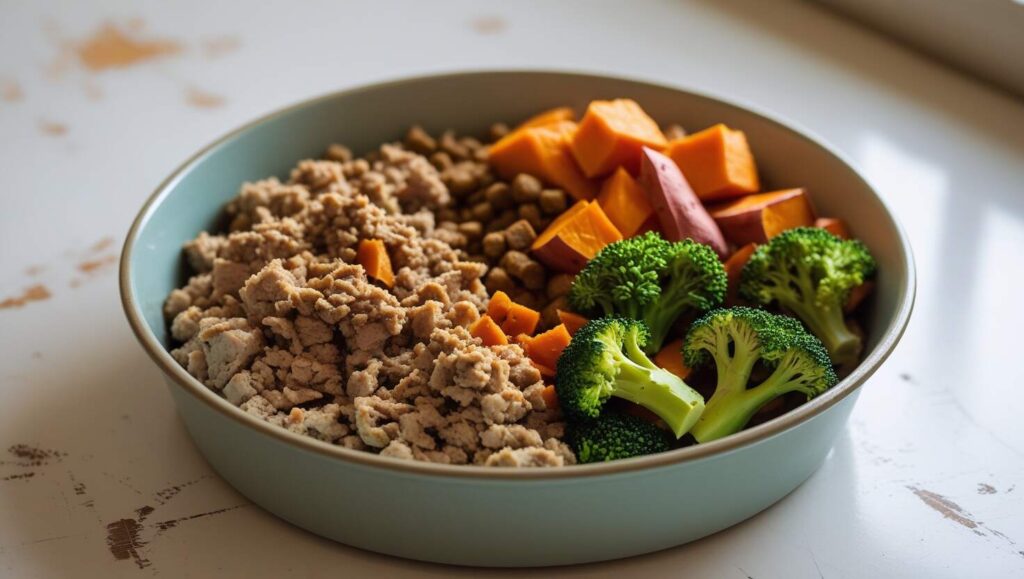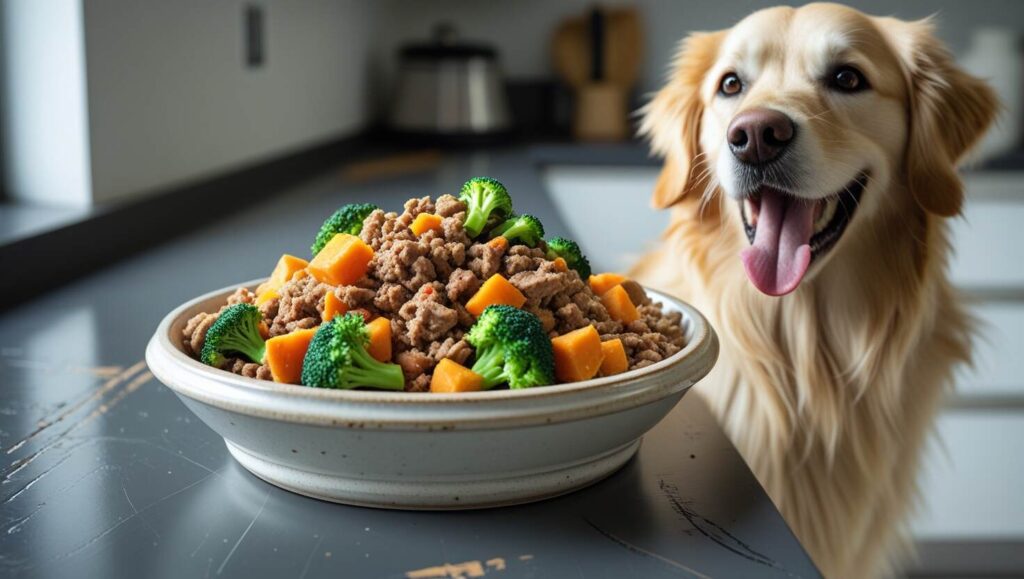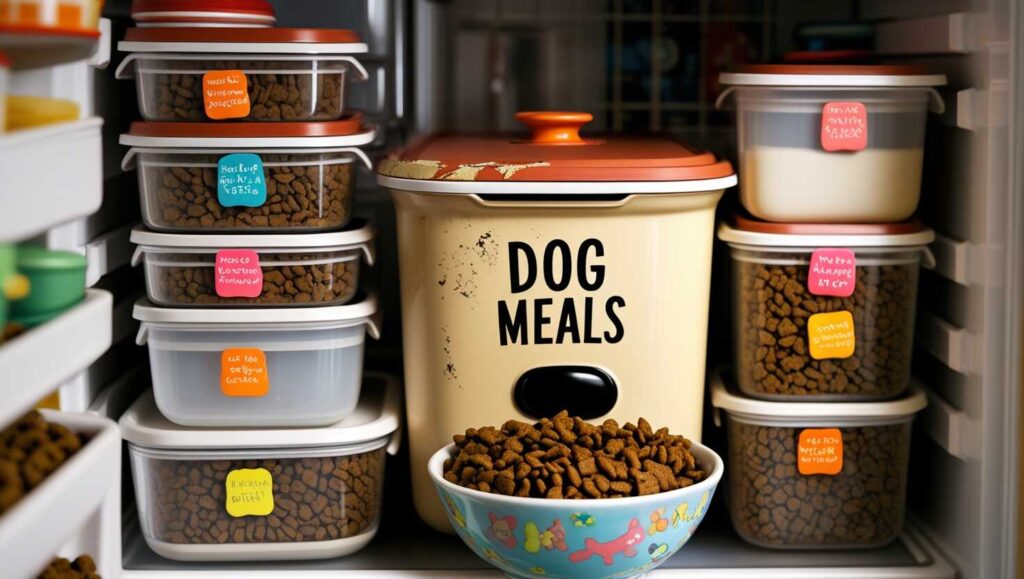Homemade Dog Food Recipes

Homemade dog food allows you to create nutritious, balanced meals tailored to your dog’s unique needs, ensuring they receive high-quality ingredients without unnecessary additives or preservatives. By consulting with a veterinarian and carefully preparing recipes, you can support your dog’s health, energy, and overall well-being.
Understanding Homemade Dog Food

Why More Owners Are Switching to Home-Cooked Meals
Homemade diets are growing in popularity, especially as owners want their dogs to eat healthier and avoid risks like dog food recalls. Many are drawn to the idea of using whole food ingredients instead of relying on heavily processed dry or wet dog food. Preparing meals at home allows owners to control ingredients, ensuring meals are tailored for their pets’ unique needs—whether that means addressing food allergies or crafting a diet for a full-sized male Golden Retriever weighing 64 pounds like my Rascal. After switching to home-cooked meals, Rascal became more energetic, calmer, and even put on 15 pounds in a year, reaching a healthy weight class.
However, home-cooking comes with responsibilities. Meals must be complete and balanced to avoid mistakes like feeding an incomplete or imbalanced diet. Owners need to measure ingredients properly, follow a consistent eating schedule, and occasionally change recipes periodically to keep meals interesting for picky eaters. While home-cooking can seem daunting, it’s often less expensive than commercially prepared options, with the added benefit of being fresh and free from unnecessary additives. I’ve found that by preparing meals regularly and planning ahead, it’s possible to create the right recipe for your dog’s needs without breaking the bank.
Key Points for Creating a Healthy Canine Diet
Understanding the basics of a homecooked diet is essential to ensure your dog gets a balanced and nutritious meal. A proper canine diet must include specific ingredients like protein, fats, carbohydrates, and essential nutrients. Protein sources such as chicken, turkey, beef, and salmon provide amino acids that dogs’ bodies cannot produce on their own. These proteins help maintain energy levels, build muscle structure, and support overall health. Adding animal fats or plant-based oils like flaxseed oil and fish oil enhances taste and ensures the diet includes the necessary fatty acids for a shiny coat and healthy cells.
Don’t overlook other important components like carbohydrates and vitamins. Carbohydrates from brown rice, oatmeal, and quinoa supply energy and promote proper gastrointestinal system functioning, especially when paired with fiber-rich foods like carrots and dark leafy greens. Essential nutrients such as vitamins A, B, D, and E, as well as minerals like calcium, iron, and zinc, support growth, strong bones, and a robust immune system. Ingredients like liver, green vegetables, and whole grains are great sources for these. Always include clean fresh water in your dog’s diet to keep them hydrated and thriving. With the right mix of ingredients, your dog can enjoy meals that are both delicious and tailored to their health needs.
Ensuring Dogs Get the Right Calories
Dogs need enough calories to meet their daily caloric need based on their life stage, activity level, and nutritional requirements. According to the Merck Veterinary Manual, a balanced diet must include protein, carbohydrates, fiber, fat, and vitamins to be complete. For example, 10% of the meal can come from chicken, turkey, or lean beef, while 50% can include energy-rich foods like rice, potatoes, and green beans. Healthy fats like vegetable oil should make up about 5.5%, and dog-specific supplements from a reputable company like BalanceIT.com can fill any gaps. Before cooking, it’s a crucial step to talk to a veterinarian or get a referral to a veterinary nutritionist to ensure the recipes meet your dog’s specific canine nutrition needs.
Steps for Preparing Homemade Dog Food

To get started with making your own dog food, you’ll need a recipe that is complete and balanced for your dog’s dietary needs. Consult a vet to ensure your chosen recipe is appropriate for your dog’s weight, activity level, and caloric needs. Gather tools like a food scale, food processor, and measuring cups to ensure accuracy in portioning and mixing. Use fresh, high-quality ingredients, avoiding anything seasoned or heavily processed. Set up a clean area in your kitchen to prepare meals safely, and remember to keep harmful foods like onions and garlic out of reach.
For a simple batch, you can use ingredients like ground turkey, sweet potatoes, carrots, zucchini squash, and broccoli, cooked with all-natural chicken stock or water. Add healthy fats like olive oil, coconut oil, or salmon oil, and don’t forget to include supplements like calcium citrate for strong bones. For 20 lb. dog with minimal activity, smaller portions may suffice, while a 40 lb. dog might require double the amount. If your dog is highly active, you’ll need to monitor and adjust portions based on their caloric needs. Cooking can be done in a Dutch oven or a crockpot, with ground meat and vegetables slowly simmered over high heat for 4 hours.
After the cooking process, allow the food to cool and then portion it into Tupperware or freezer-safe containers. Refrigerated food can last for three to four days, while frozen dog food is good for up to six months. If meal prepping in bulk, make smaller quantities for immediate use and freeze the rest in pre-portioned bags. My dog Rascal loves this setup—his meals are tailored just for him, and the prep ensures I always have a finished batch ready for his next meal. With a bit of planning and effort, you can create a diet that’s nutritious and enjoyable for your dog.
Cooking & Recipes
Easy Steps to Cook a Nutritious Meal
Start by adding ground turkey, water, and a cup of rice with a pinch of rosemary into a large Dutch oven. Stir the mixture until the turkey is broken up and evenly distributed. Bring it to a boil over high heat, then reduce the heat to low and let it simmer for about 20 minutes. Add a handful of frozen vegetables and cook for an additional 5 minutes before removing from the heat. Allow the food to cool completely before serving. For a smoother texture, you can use a food processor or coffee grinder to pulse organ meat like turkey liver into a finely grated form, then mix it into the prepared meal. Blanching vegetables before adding them can enhance nutrient absorption and make the meal easier for your pet to digest, ensuring your dog eats a delicious and healthy meal every time.
Simple and Healthy Sample Recipes
When creating homemade diets for healthy dogs, it’s crucial to use a nutritionally balanced recipe approved by veterinarians. For a general-use recipe suited for an average 15-lb adult dog, consider combining chicken breasts with sweet potato, mashed carrots, and peas. Cook the chicken breasts thoroughly and mash the vegetables, adding a drizzle of olive oil for healthy fats. This recipe is rich in lean protein to support muscle development and repair, as well as fiber and vitamins A, C, and B6 to promote healthy eyesight and immunity. Use a dietary gram scale or food scales to measure the ingredients for precise portions and prevent imbalanced intake of nutrients.
For variety, you can try a nutrient-rich mix of ground beef, brown rice, broccoli, and spinach, topped with blueberries for added antioxidants. This blend provides amino acids for strong muscles, complex carbohydrates for sustained energy, and fiber for digestive health. Blending the ingredients ensures that your pet consumes the entire mixture, which helps prevent picking out preferred items. Remember to adjust cooked weights to account for water content and portion according to your dog’s weight and activity level.
Another tasty option is tuna with quinoa, green beans, and a touch of coconut oil for added omega-3 fatty acids, promoting a healthy skin and shiny coat. This gluten-free dish supports weight management and is gentle on the digestive system. For dogs with specific needs, consider turkey with pumpkin puree, flaxseed oil, and lightly steamed zucchini baked in a baking dish. The dietary fiber in pumpkin helps regulate digestion, while the essential fatty acids in flaxseed oil support overall health. Always weigh foods carefully and talk to your veterinarian to ensure the recipes meet your dog’s dietary needs for a nutritious diet.
Making Healthy Meals for Your Best Friend
Preparing home-cooked dog food is a wonderful way to keep your best friend happy and healthy. Start with high-quality protein sources like ground turkey, chicken, or lamb, which can be ground at home using a meat grinder or purchased pre-cut from a butcher. Add nutrient-rich vegetables such as spinach, butternut squash, and green beans, along with wholesome grains like rice, quinoa, or barley, to provide essential carbs. For treats, consider stuffing a Kong with peanut butter or mixing Greek yogurt with berries in a silicone cupcake pan and freezing it for a fun summer snack. Always check with a vet before introducing a new diet to ensure it meets your dog’s needs, just as I did for Rascal.
Nutritional Essentials for Your Dog’s Meals
Every recipe should provide the right balance of nutrients, including protein, fat, and carbs, to meet your dog’s daily needs. Add ground parsley or burdock root for extra vitamins, while zucchini and leafy greens supply fiber and antioxidants. Incorporate cod liver oil, used 3 x week, as it supports overall health and may aid in cancer prevention. To ensure your dog gets everything they need, include supplements tailored to their diet and consult a vet for a nutritional analysis. Adjust portion sizes based on your dog’s calories and activity level to maintain optimal health.
Proper Feeding and Storing Tips for Homemade Dog Food

When feeding your dog homemade food, it’s important to monitor their weight, body condition, and overall energy level weekly. Look for any signs of vomiting, diarrhea, or sensitivity to certain ingredients, as these may indicate a need to adjust the recipe or consult a veterinarian. Gradual changes are essential when introducing homecooked meals; start by mixing small portions of the new food with their current diet over five to seven days to help their GI system adjust. Work closely with a veterinary nutritionist to ensure the food meets your dog’s nutritional needs, considering their age, size, and health history. Keep a record of any changes in your dog’s condition and follow recommendations from trusted sources like the Tufts Cummings Veterinary Medical Center or studies in the Journal of the American Veterinary Medical Association.
For storing, prepare up to a week’s worth of meals and keep them in airtight Tupperware containers or freezer-safe zip-top bags. Store daily portions in the refrigerator for easy access and freeze the rest, thawing portions overnight as needed. When reheating, use a microwave or stove and allow the food to cool before feeding your dog. Avoid substituting ingredients randomly, as this could lead to nutritional deficiencies. Proper storage and preparation—like steaming, boiling, or roasting food—will help retain essential nutrition and keep your dog healthy and happy.
Kindly note: The content shared in this blog is gathered from online sources, some of which may not be verified. For accurate guidance on caring for your dog, it is recommended to seek advice from a qualified veterinarian.

